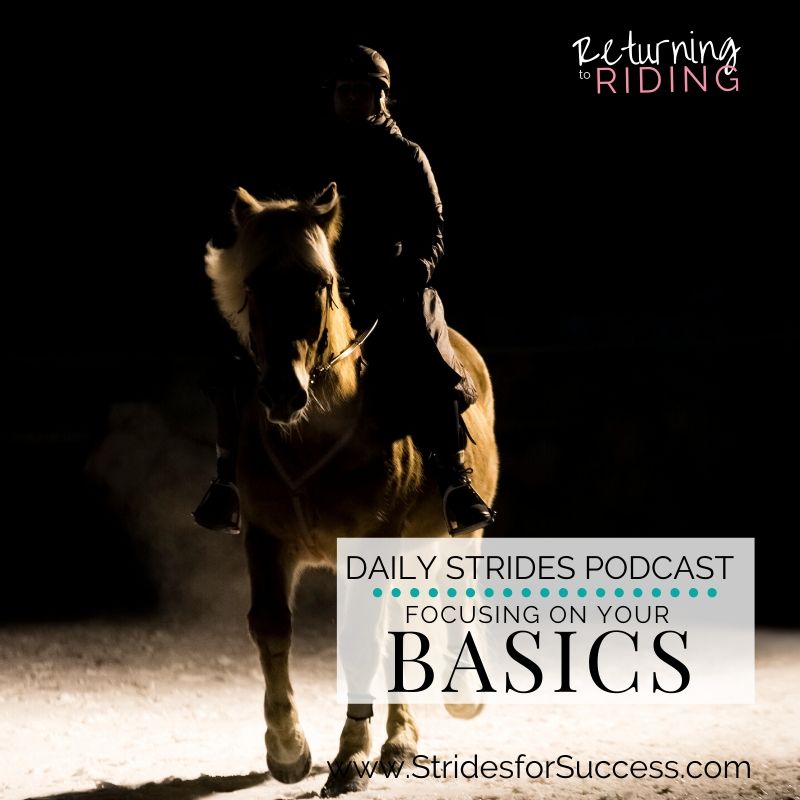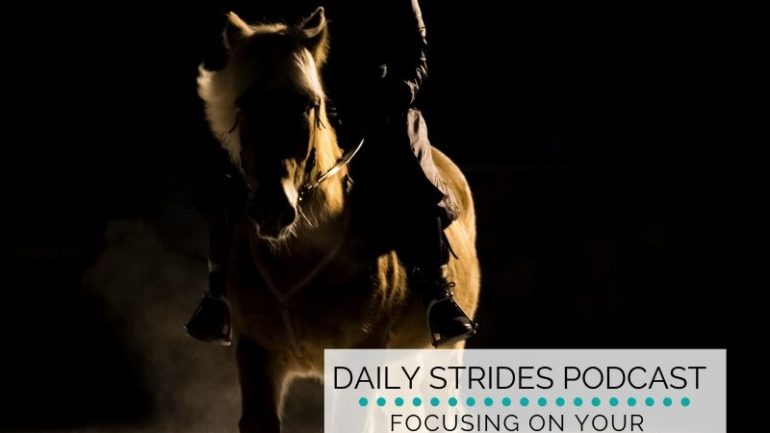
You’ve decided to refocus your attention on your riding. You’re back in the saddle and rearing to go (well, maybe not quite rearing!). But knowing what to do and where to focus your attention can seem a little daunting. In fact, maybe it’s feeling like there is just too much to do and too little time to do it in…
If we were working together, either online or in-person, there are a few essentials that I would begin asking you to give your full attention to. Now, obviously this would vary depending on your unique situation. However, there is a foundation that you build in your riding which is centered on a few specific principles. Today I want to share those with you…
Focusing on the Basics is for Novice Riders…
My ‘definition’ of a novice rider is if you spend the majority of the time in the saddle focusing on yourself and trying to maintain what you are doing.
Now, obviously we all focus on ourselves in the saddle. However, it is the intention behind the focus that shifts and changes. When I say that novice riders focus on themselves, it is to try and get a few things on autopilot initially. If this is you, you are possibly trying to get your position right. Or trying to coordinate your aids. Maybe even the timing of those aids or the sequence of them…
I feel that riders ‘graduate’ from a novice when the majority of the time in the saddle becomes about how the horse is going and what they can do to better influence that.
If you feel that you are more in the second category of riders, I am going to suggest this episode on ……….. which will better suit you right now in your riding.
1 . Choose One Source of Advice and Opinion
This may seem like a no brainer, however, this one piece of advice has the potential to either help you jump start your riding or stall… When I first became pregnant, a good friend gave me a ‘golden nugget’ with this same piece of advice. She basically told me to choose one person who I trusted or admired with regards to parenting – and, this is the important part, only seek their advice. At the time, I glossed over it, however, 3.5 years later, I now realize that this advice was GOLDEN!
Different riders and instructors have different approaches. Most are good and will give similar results at the end of the day. However, it is when we begin mixing techniques and strategies, things becoming confusing very quickly. This is for both the horse and the rider.
Choose a rider, instructor or coach that you trust and admire. Then remember to seek their opinion or advice whenever you feel unsure or ‘stuck’ in your riding.
As you become more experienced, you can then begin ‘blending’ advice from different sources. In fact, I highly recommend that you do. The reason I suggest waiting is that you are surer of your own perspective and how this different advice applies to you. However, if you are a novice right now – pick one person or source. Just one. Trust me, this one golden nugget made ‘parenting’ a whole lot easier for me!
2 . Get to Know Your Aids
I realize that you probably know what your aids are. As in, if I asked you to list them, you probably could. When I say ‘know’ your aids, I am asking you to take things one step further. I want you to begin really understanding your aids and why they work the way that they do.
I see so many novice riders become stalled by focusing just on one aid. A place where I see this happen over and over is the transition between trot and canter. Novice riders put too much effort into either the outside leg or the inside seat bone. Yes, they are important. But they work ‘with’ the other aids.
How your aids interact together is really how your aids work . No aid will ever be a ‘stand alone’ event; there are always supporting roles when it comes to your other aids and the overall communication and message
Your aids work together. Coordination plays a big part in how they interact and play together. I am going to suggest spending time ‘figuring out’ how your body works. The simple things are often the very things that get overlooked. Start with ‘when I move my leg like this, my seat does that’ mindfulness and then begin adding your horse’s response into the mix.
My advice is to devote 3 months to really learning about your aids and how they ‘work’. Three months is a small investment when you realize that this will change everything for you and your riding going forward
3 . Your Position
I know, again, so basic we often forget. But your position is vital if you are to be understood correctly by your horse. You can talk and talk until the cows come home. Your aids are how you speak to your horse. However, if you are in the wrong position, you will either not be heard, or be misunderstood.
There are a few basics you can adhere to. The simple ‘lines’ is always a great way to quickly assess how you are doing. So too is the ‘Click Your Fingers Rule’. Simple but powerful. However, it is when things begin moving, that I find most riders really begin struggling with their position.
Work on assessing your position as you prepare yourself and your horse for an upcoming change. Associating a quick ‘check’ of your position to your half-halt is one way of ensuring this is working for you.
Notice where you struggle to maintain your position. And realize that bad posture is a position issue. Work on ways outside of the saddle that you can use to strengthen what is going on when you are riding.
Your communication will always be ‘jumbled’ as long as you are struggling to carry yourself in the saddle.
4 . Begin Assessing Your Horses Way Of Going
The reason so many riders never really graduate on from being a novice rider, is often because they are unsure as to what they are moving on to. Where is the conversation going to? This is especially true if they have no ambition to compete, sell or jump their horse.
Developing the horses way of going is a really worthwhile project for all riders.
I feel that, regardless of how ‘novice’ you are, if you approach things with a sense of how it is impacting the horse, you will find the transition from passenger to rider a far smoother one. Start small with something noticeable and easy to recognize such as rhythm.
Questions like ‘if I apply this aid, does it have an impact on my horse’s rhythm in trot?’ are really valuable questions to begin asking yourself when in the saddle.
You are never too ‘green’ to take how your horse is going into consideration. I also find that this encourages compassion in riders as well. ‘Oh, my horse doesn’t seem to enjoy that’. Or, ‘gosh, when I lean like this my horse responds by doing this’…
Once you begin thinking this way, it will inspire you to up your game where your riding is concerned. It will motivate you to do ‘uncomfortable things’ to really show up as a better version of yourself in the saddle.
The Coming 3 Months in Your Riding
I am going to challenge you, today, to choose something and create a project around it for the coming 3 months. Whatever today’s date is, as you read this, simply go on three months – and there is your ‘finish date’. Allow all of your rides between here and there to move you in some way towards a specific outcome or goal.
This is also possible if you are only riding once a week. Do some literal ‘home-work’ before each ride so that you have a better idea when you are in the saddle of what is happening.
You can also work on your physical and mental conditioning over the 3 months as well. What limitations are you setting for yourself, whether intentionally or not? Are there patterns that may be served you in the past, but are now holding you back from moving forward?
If you would like more help with this, I am going to suggest considering joining me inside of the Returning to Riding program. You can find out more about it HERE
Happy Riding
Lorna
Other Resources, Episodes and Posts Relating to This Topic:-
-
-
-
- The Returning to Riding Program – More Information
- Lunging for Riding -success in just 10 minutes or less each day
- Groundwork for Riding – Successfully Take the Conversation from the Ground into the Saddle
- Returning to Riding – Step by Step
- Returning to Riding – Great Expectations
- Returning to Riding – Choosing Your Mindset
- The Daily Strides Podcast
- The Free Group filled with other like-minded riders
- 2020 Equestrian Fitness Challenge
-
-

